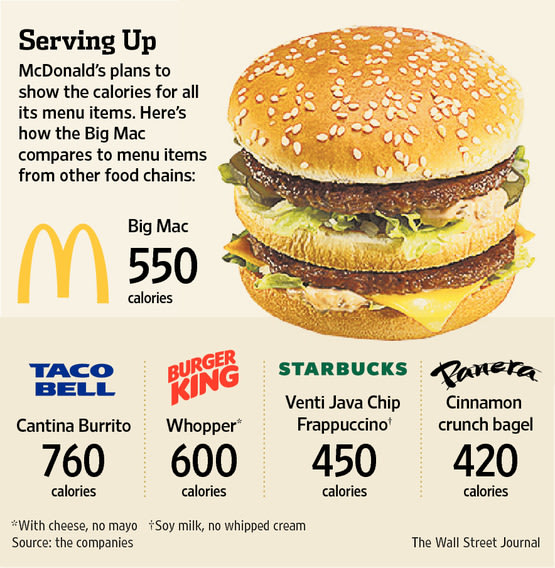Torn between a Big Mac and a Double Quarter Pounder with Cheese?  Some chains, such as Panera Bread Co. (PNRA) and Au Bon Pain, already post calories on their menus, but McDonald's is the largest chain and the first fast-food company to do so on a national level. The push is part of an effort to get out ahead of federal menu-labeling requirements. There is a market need to it too—McDonald's want to convey to customers that its not just selling junk food. The company last year added apples to all of its kids' meals and made the servings of fries smaller. Some regional studies suggest that having nutritional information available when ordering a meal prompts people to buy healthier items. Other studies have found no such change in consumer behavior. But considering how prominent restaurants have become in the American diet, any change could have an effect on obesity rates. Americans now consume roughly a third of their calories from restaurants, up from less than a quarter in the 1970s, according to the U.S. Department of Agriculture. And people spend about half of their food budgets at restaurants now, compared to a third in the 1970s. A Stanford Graduate School of Business study found that when Starbucks Corp. (SBUX) began posting calorie information in its New York City stores in April 2008, as required by city law, customers ordered items containing 6% fewer calories on average per transaction. "If we see a similar effect from other chains you'd see about a 30-calorie per person per day decrease," said Margo Wootan, director of nutrition policy at the Center for Science in the Public Interest. "The thing about obesity is it's caused by a slow, steady creep in people's weight over decades. For most of us, we're gaining one to two pounds per year steadily over decades and end up being 30 to 50 pounds overweight. The obesity epidemic is explained by about 100 extra calories per person per day, so if we get a daily 30-calorie decrease from menu labeling, that's huge."Shortly after Panera Bread posted calorie counts on its menu boards in April 2010, the company noticed that 20% of customers began ordering lower-calorie items."We think it's an important ingredient in respecting our customers and treating them as intelligent people who can make smart choices for themselves," Panera founder and co-CEO Ron Shaich said in an interview. But some caution that consumers in large numbers may not be swayed by the extra information.A report published last year in the International Journal of Behavioral Nutrition and Physical Activity, which reviewed seven studies on the topic, found that "calorie labeling does not have the intended effect of decreasing calorie purchasing or consumption." Even McDonald's hasn't yet noticed a comprehensive change in behavior in the cities and states that have already mandated calorie counts to be posted. "It hasn't seemed to have made a difference, but what it says to the customer is, 'We care about you and want to provide you with the most detailed information possible,' " McDonald's USA president Jan Fields said in an interview. New regulations requiring operators of restaurants with 20 or more outlets to post calories on menus are expected to take effect by the end of next year. Even if consumers aren't quick to change their buying habits, restaurants, in anticipation of the coming regulation, are doing the work for them. Numerous chains have either reformulated menu items to be healthier or have started steering consumers to lower-calorie choices. A study published last month in the Journal of the Academy of Nutrition and Dietetics found that 26% of entrees at 37 restaurant chains studied in King County, Washington, had reduced calories 18 months after a menu-labeling law took effect there. California Pizza Kitchen Inc. has a "small plates" section on its menu, as does The Cheesecake Factory; Denny's Corp. has "Fit Fare"; Applebee's Neighborhood Grill & Bar, a unit of DineEquity Inc., has a menu featuring items under 550 calories, and McDonald's recently grouped several menu items under the heading "Favorites Under 400 Calories." Glenn Kikuchi, owner of 10 McDonald's franchises in Maryland, said he's already seen signs that the highlighted calorie counts are having an effect. |
Ads
Space For Content and Image Ads
Contact: mohibnabigsm@hotmail.com
Highest-Calorie Menu Item at McDonald's? Not a Burger
Posted by
Anonymous
Subscribe to:
Post Comments (Atom)
Post a Comment